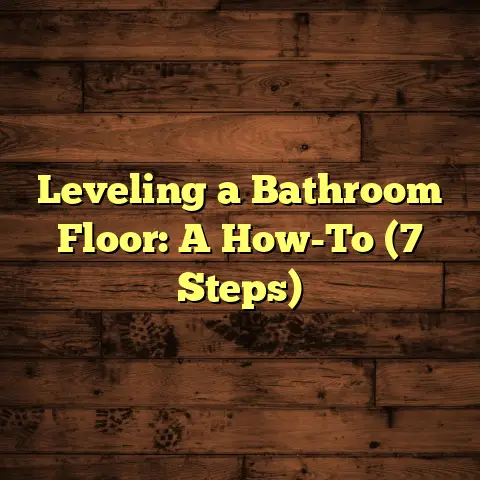Nailing Hardwood: Spacing Mistakes? (4 Errors!)
Let’s talk hardwood flooring.
Think of it like this: a perfectly installed hardwood floor is like a beautiful canvas under your feet.
It adds warmth, character, and value to your home.
But a poorly installed floor?
Well, that’s like a masterpiece marred by a glaring mistake.
One of the biggest culprits behind flooring fails?
Improper nailing and spacing.
Trust me, I’ve seen it all in my years as a flooring contractor.
Get it wrong, and you’re looking at a whole host of problems down the line.
Squeaks that drive you crazy, boards that warp and buckle, and gaps that collect dirt and dust.
In this article, I’m going to break down the four most common spacing mistakes I see when people are nailing hardwood.
We’ll dive into why these errors happen, what problems they cause, and most importantly, how to avoid them.
Ready to get started? Let’s nail it! (Pun intended, of course.)
1. Understanding Hardwood Flooring Installation
So, what exactly is hardwood flooring?
Simply put, it’s flooring made from a single piece of solid wood, typically hardwood species like oak, maple, or walnut.
It’s been a popular choice for centuries because of its durability, beauty, and timeless appeal.
But here’s the thing: hardwood isn’t just about the wood itself.
It’s about the installation.
Proper installation is absolutely crucial for getting the most out of your investment.
And when it comes to installation, nailing and spacing are key.
Why?
Because wood is a natural material, it expands and contracts with changes in humidity and temperature.
Think of it this way: during humid summer months, the wood absorbs moisture and swells.
In dry winter months, it loses moisture and shrinks.
If you don’t account for this natural movement during installation, you’re setting yourself up for trouble.
That’s where proper nailing and spacing come in.
By nailing the boards correctly and leaving adequate space for expansion, you allow the floor to “breathe” and move without causing damage.
It’s a delicate balance, but getting it right is essential for a long-lasting, beautiful floor.
2. Error #1: Inconsistent Nail Spacing
Okay, let’s jump into the first big mistake: inconsistent nail spacing.
What exactly does that mean?
It simply means that the nails aren’t evenly spaced across the floor.
Some areas might have too many nails, while others might not have enough.
I often see this when people are rushing the job, or when they’re not paying close attention to their measurements.
They might start out strong, with consistent spacing, but then they get tired or distracted and start to get sloppy.
So, why is inconsistent nail spacing such a big deal?
Well, for starters, it can lead to squeaky floors.
If some boards are more securely fastened than others, they’ll rub against each other when you walk on them, creating those annoying squeaks.
Beyond the noise, inconsistent spacing can also cause warping and gapping.
If some areas are nailed too tightly, the wood can’t expand and contract properly.
This can put stress on the boards, causing them to warp or pull away from each other.
I had a client once who tried to save time by “eyeballing” the nail spacing.
Big mistake!
Within a year, their floor was a symphony of squeaks, and they had noticeable gaps between the boards.
It ended up costing them way more to fix the problem than it would have to do the job right in the first place.
How can you tell if you have inconsistent nail spacing?
A good way is to simply look closely at the floor.
Do the nail holes appear to be evenly spaced?
Are there any areas where the nails seem to be clustered together, or where there are large gaps between nails?
You can also use a tape measure to check the spacing.
A standard nail spacing for hardwood is typically 6-8 inches along the edges and 8-10 inches in the field (the middle of the board).
Of course, this can vary depending on the type of wood, the thickness of the boards, and the manufacturer’s recommendations.
Always consult the installation instructions for your specific flooring product.
Here’s a quick tip: I always recommend using a nail spacing guide.
You can make one yourself out of a piece of wood or cardboard, or you can buy one online.
Simply mark the desired nail spacing on the guide, and use it as a template to ensure consistent spacing across the floor.
3. Error #2: Incorrect Nail Placement
Next up, let’s talk about nail placement.
It’s not just about how many nails you use, but also where you put them.
Nailing in the wrong spots can be just as damaging as inconsistent spacing.
The ideal nail placement for hardwood is near the tongue of the board.
The tongue is the projecting edge that fits into the groove of the adjacent board.
Nailing through the tongue allows the nail to be concealed by the next board, creating a clean, professional look.
However, I often see people making a couple of common mistakes:
-
Nailing too close to the edge: This can cause the wood to split or crack, especially if you’re working with a brittle species like some types of exotic hardwoods.
Missing the tongue altogether: If you miss the tongue, the nail won’t be properly concealed, and it won’t provide adequate holding power.
This can lead to loose boards and squeaky floors.
What’s the impact of these errors?
Well, for starters, it can compromise the structural integrity of the floor.
If the nails aren’t properly secured, the boards can shift and move, leading to instability.
It can also affect the aesthetics of the floor.
Visible nail holes are unsightly and can detract from the overall beauty of the wood.
I remember one job where the homeowner had tried to install the floor themselves, but they kept missing the tongue with their nails.
The result was a floor riddled with visible nail holes, and the boards were already starting to come loose after just a few months.
They ended up having to tear out the entire floor and start over.
To avoid these mistakes, it’s essential to use the right tools and techniques.
I highly recommend using a flooring nailer, also known as a cleat nailer or hardwood floor nailer.
This tool is specifically designed to drive nails at the correct angle and depth, ensuring a secure and concealed fastening.
There are two main types:
Manual nailers: You strike these with a mallet to drive the nail.
They’re typically less expensive, but they require more physical effort.Pneumatic nailers: These are powered by compressed air, making them faster and easier to use.
They’re a bit more expensive, but they’re well worth the investment if you’re doing a large flooring project.
When using a flooring nailer, make sure to hold it firmly against the tongue of the board, and apply even pressure when driving the nail.
If you’re using a manual nailer, be careful not to hit too hard, as this can damage the wood.
If you’re not comfortable using a flooring nailer, you can also use a nail set and a hammer.
A nail set is a small metal punch that you use to drive the nail below the surface of the wood.
This allows you to conceal the nail hole with wood filler.
4. Error #3: Neglecting Expansion Gaps
Now, let’s talk about expansion gaps.
This is one of the most overlooked aspects of hardwood flooring installation, but it’s absolutely crucial for preventing future problems.
So, what exactly is an expansion gap?
It’s a small space that you leave around the perimeter of the room, between the edge of the flooring and the wall or other fixed structures.
This space allows the wood to expand and contract with changes in humidity and temperature, without putting pressure on the surrounding structures.
I typically recommend leaving a 1/4- to 1/2-inch expansion gap, depending on the width of the room and the type of wood.
Consult the manufacturer’s recommendations for your specific flooring product.
Why is it so important to leave these gaps?
Well, if you don’t, the wood will eventually run out of room to expand.
This can put tremendous pressure on the walls and other fixed structures, leading to buckling, cracking, and even structural damage.
I’ve seen floors that have literally lifted off the subfloor because the installer didn’t leave adequate expansion gaps.
It’s a costly mistake that’s easily avoidable.
I always recommend using spacers to maintain consistent expansion gaps.
You can buy these online or at your local hardware store.
Simply place the spacers between the flooring and the wall as you install the boards.
Once the floor is installed, you can cover the expansion gaps with baseboards or quarter-round molding.
This will give the floor a finished look while still allowing for expansion.
Here’s a pro tip: Don’t just leave expansion gaps along the walls.
You also need to leave gaps around any fixed objects, such as pipes, columns, or kitchen islands.
Use a jigsaw or other cutting tool to carefully cut the flooring around these objects, leaving the appropriate expansion gap.
5. Error #4: Over-Nailing or Under-Nailing
Alright, let’s tackle the final mistake: over-nailing or under-nailing.
As the names suggest, over-nailing means using too many nails, while under-nailing means not using enough.
Both mistakes can have negative consequences for your floor.
What happens if you over-nail?
Well, for starters, you can damage the wood.
Too many nails can weaken the boards, making them more prone to splitting and cracking.
Over-nailing can also restrict the natural movement of the wood.
This can lead to buckling and warping, especially in areas with high humidity.
What about under-nailing?
Under-nailing is equally problematic.
If you don’t use enough nails, the boards won’t be properly secured to the subfloor.
This can lead to loose boards, squeaky floors, and even tripping hazards.
So, how do you determine the correct number of nails?
As a rule of thumb, I recommend following the manufacturer’s recommendations for your specific flooring product.
They will typically specify the nail spacing based on the type of wood, the thickness of the boards, and the width of the room.
If you can’t find the manufacturer’s recommendations, a good general guideline is to use nails every 6-8 inches along the edges and every 8-10 inches in the field.
Remember, it’s always better to err on the side of using slightly more nails than fewer.
However, don’t go overboard.
Too many nails can be just as bad as not enough.
I’ve developed a little checklist that I use to ensure proper nailing:
- Use the right type of nails: Use nails that are specifically designed for hardwood flooring.
These nails typically have barbed shanks that provide a strong grip. - Use the right size of nails: The length of the nails should be appropriate for the thickness of the flooring.
- Use a nail spacing guide: This will help you maintain consistent spacing across the floor.
- Check your work regularly: As you install the floor, take a moment to inspect your work.
Make sure the nails are properly seated and that the boards are securely fastened.
Conclusion
So, there you have it: the four most common spacing mistakes I see when people are nailing hardwood flooring.
By understanding these errors and taking steps to avoid them, you can ensure a flawless finish and a floor that will last for years to come.
Remember, hardwood flooring is a beautiful and valuable investment.
Take the time to do the job right, and you’ll be rewarded with a floor that enhances the beauty and value of your home.
Don’t be afraid to ask for help if you’re unsure about anything.
There are plenty of resources available online and at your local hardware store.
You can also hire a professional flooring contractor to handle the installation for you.
Ultimately, the goal is to create a floor that you can be proud of.
A floor that’s not only beautiful but also durable, comfortable, and safe.
Now go out there and nail it!
(Okay, I promise that’s the last pun.) Good luck with your flooring project!





